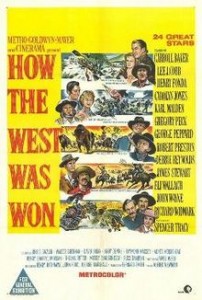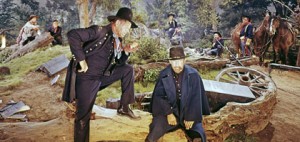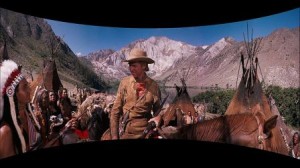 The epic journey of four generations of Americans who carved a country with their bare hands.
The epic journey of four generations of Americans who carved a country with their bare hands.
How the West Was Won marked the pinnacle of what perhaps was the first major technological attempt of the major studios to push back against the rise of television and dwindling cinema attendance. This major innovation was Cinerama, which was shot with a bulky three camera setup, with the resulting film being screened over a huge 146 degree arcing screen.
This method gave a very immersive visual experience to the viewer and also utilized a seven speaker sound system, which was also very innovative for the time. Crowds loved it. Probably the nearest thing we have to it today is IMAX.
 Originally, much like IMAX is primarily utilized today, Cinerama films were travelogues, with only two “traditional” films being made for the original three strip format. These were The Wonderful World of the Brothers Grimm and How the West Was Won.
Originally, much like IMAX is primarily utilized today, Cinerama films were travelogues, with only two “traditional” films being made for the original three strip format. These were The Wonderful World of the Brothers Grimm and How the West Was Won.
Due to the technical challenges of filming and synching three cameras along with the soundtrack so that everything would match during presentation and the discovery that a single super widescreen camera produced a somewhat similar effect, Cinerama faded from the public eye and is now a bit of a curiosity.
How the West Was Won has a plot but also has the somewhat typical Cinerama documentary feel to it as we follow a fictional American family through several generations on the Western Frontier. We pass from the 1830s through the end of the century and hit all the anticipated high points along the way: Westward Expansion, a Native American attack on a wagon train, the Civil War, and the coming of the railroads, among other things.
Given the scope the film never quite gels into a coherent product. It was shot in an episodic nature, with five set pieces, directed by three directors. Henry Hathaway directed three, with John Ford and George Marshall doing one apiece. Each segment becomes much better when you take it individually apart from the remainder of the picture as each piece has its own mini plot; setting the stage, a bit of exposition, and a dramatic climax.
As you can imagine, with the technical challenges, extensive cast, multiple directors, and extremely long time period to be covered on screen, the end product is a bit disjointed and does not fit together overly well.
 The cast is like a who’s who of the time, and something which you’d expect now in a miniseries or the like. Among others we have Carroll Baker, Jimmy Stewart, John Wayne, Henry Fonda, Karl Malden, Debbie Reynolds, Gregory Peck, George Peppard, and Spencer Tracy all play here. Tracy is never seen, serving as merely a narrator between episodes. The all do an okay job but no one really is on screen long enough to hold your attention for long.
The cast is like a who’s who of the time, and something which you’d expect now in a miniseries or the like. Among others we have Carroll Baker, Jimmy Stewart, John Wayne, Henry Fonda, Karl Malden, Debbie Reynolds, Gregory Peck, George Peppard, and Spencer Tracy all play here. Tracy is never seen, serving as merely a narrator between episodes. The all do an okay job but no one really is on screen long enough to hold your attention for long.
How the West Was Won was one of the earliest classic films to be released on blu-ray and as usual from Warner Brothers the packaging is wonderful. The film looks quite good and for the most part the dividing seams between each camera field have been removed digitally. The film is presented in two different formats – one a fairly standard widescreen, which is very “wide” to accommodate all the film. Second is a new format called “SmileBox” which is intended to attempt to show the film as it would have appeared for original viewers in a Cinerama theater.
 Neither completely won me over but that isn’t anyone’s fault, merely a function of the size of the original feature. The ‘created’ standard widescreen simply is too narrow unless you have a mammoth screen – or sit very close. Although many have appreciated and enjoyed the SmileBox format, it is merely an attempt and only gives anything approaching the required impact when you touch your nose to the screen. (Yes, that is a slight exaggeration.) I found it a bit strange and obtrusive but that could just be me.
Neither completely won me over but that isn’t anyone’s fault, merely a function of the size of the original feature. The ‘created’ standard widescreen simply is too narrow unless you have a mammoth screen – or sit very close. Although many have appreciated and enjoyed the SmileBox format, it is merely an attempt and only gives anything approaching the required impact when you touch your nose to the screen. (Yes, that is a slight exaggeration.) I found it a bit strange and obtrusive but that could just be me.
The video quality is superb and the audio sounds even better. Alfred Newman’s classic score definitely has a punch, even more so than before. It is still a bit over the top given the film itself though. There is also a good batch of supplemental materials here which all will enjoy, including a good documentary about Cinerama in general. This isn’t really a movie you’ll find yourself viewing many times over, but it is one of the last attempts at an epic western in the old style. Definitely worth a gander.
No review copy provided.